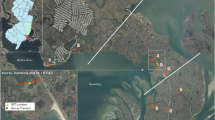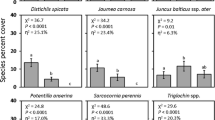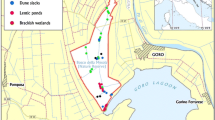Abstract
Marshes of the Mississippi River Deltaic Plain represent 17% of the coastal marshes in the continental United States. However, only a few detailed descriptions of the diverse plant communities that occur in this large expanse of wetlands exist and none are based on detailed vegetation analysis. The objective of this study was to quantitatively analyze the vegetation data collected in the wetlands of the Barataria and Terrebonne estuary to determine naturally occurring vegetation associations. Two-way indicator species analyses (TWINSPAN) revealed nine vegetation types: polyhaline mangrove, polyhaline oystergrass, mesohaline mix, mesohaline wiregrass, oligohaline wire grass, oligohaline mix, fresh bulltongue, fresh maidencane, and fresh cutgrass. These nine types form a logical expansion on the four salinity zone described for the region by previous studies and form a basis to compare the vegetation types of the Mississippi River Delta region with other regions of the Atlantic and Gulf coasts.
Similar content being viewed by others
Literature Cited
Bertness, D. M. andA. M. Ellison. 1987. Determinants of pattern in a New England salt marsh plant community.Ecological Monographs 57:129–147.
Boesch, D. F., M. N. Josselyn, A. J. Mehta, J. T. Morris, W. K. Nuttle, C. A. Simmenstad, and D. J. P. Swift. 1994. Scientific assessment of coastal wetland loss, restoration and management in Louisiana.Journal of Coastal Research Special Issue 20.
Chabreck, R. H. 1970. Marsh zones and vegetative types in the Louisiana coastal marshes. Ph.D. Dissertation, Louisiana State University, Baton Rouge, Louisiana.
Chabreck, R. H. 1972. Vegetation, water, and soil characteristics of the Louisiana coastal region.Louisiana State University Agricultural Experiment Station Bulletin No. 664. Louisiana State University, Baton Rouge, Louisiana.
Chabreck, R. H., J. T. Joanen, andA. W. Palmisano. 1968. Vegetative type map of the Louisiana coastal marshes. Louisiana Wildlife and Fisheries Commission. New Orleans, Louisiana.
Chapman, V. J. 1960. Salt Marshes and Salt Desserts of the World. Interscience, New York.
Chapman, V. J. 1977. Wet Coastal Ecosystems. Elsevier, Amsterdam, The Netherlands.
Correll, D. S. andH. B. Correll. 1975. Aquatic and Wetland Plants of Southwestern United States Stanford University Press, Stanford, California.
Craig, N. J., R. E. Turner, andJ. W. Day, Jr. 1979. Land loss in coastal Louisiana (USA).Environmental Management 3:133–144.
Dale, M. B. 1995. Evaluating classification strategies.Journal of Vegetation Science 6:437–440.
Eleuterius, J. N. 1976. The distribution ofJuncus roemerianus in the salt marshes of North America.Chesapeake Science 17:289–292.
Evers, D. E., J. G. Gosselink, C. E. Sasser, andJ. M. Hill. 1992. Wetland loss dynamics in southwestern Barataria basin, Louisiana (USA), 1945–1985.Wetlands Ecology and Management 2: 103–118.
Evers, D. E., G. O. Holm, and C. E. Sasser. 1996. Digitization of the floating marsh maps if the Barataria and Terrebonne basins, Louisiana. Barataria-Terrebonne National Estuarine Program, BTNEP Publication Number 28. Thibodaux, Louisiana.
Field, D. W., A. J. Reyer, P. A. Genovese, andB. D. Shearer. 1991. Coastal Wetlands of the United States: An accounting of a valuable national resource. Special NOAA 20th Anniversary Report, National Oceanic and Atmospheric Administration and United States Fish and Wildlife Service, Washington, D.C.
Gagliano, S. M., K. J. Meyer-Arendt, andK. M. Wicker. 1981. Land loss in the Mississippi River deltaic plain.Transactions of the Gulf Coast Association of Geological Societies 31:295–300.
Godfrey, R. K. andJ. W. Wooten. 1981. Aquatic and Wetland Plants of Southeastern United States. University of Georgia Press, Athens, Georgia.
Hill, M. O. 1979. Twinspan—A FORTRAN Program for Arranging Multivariate Data in an Ordered Two-way Table by Classification of the Individuals and Attributes. Cornell University Press, Ithaca, New York.
Kushlan, J. A. 1990. Freshwater marshes, p. 324–363.In R. L. Meyers and J. J. Ewel (eds.), Ecosystems of Florida University of Central Florida Press, Orlando, Florida.
Montague, C. L. andR. G. Wiegert. 1990. Salt marshes, p. 481–516.In R. L. Meyers and J. J. Ewel (eds.), Ecosystems of Florida, University of Central Florida Press, Orlando, Florida.
Niering, W. A. andR. S. Warren. 1980. Vegetation patterns and processes in New England salt marshes.Bioscience 30:301–307.
Odum, W. E., T. J. Smith, III, J. K. Hoover, and C. C. McIvor. 1984. The ecology of tidal freshwater marshes of the United States east coast: A community profile, U.S. Fish and Wildlife Service. FWS/OBS-83/17.
O’Neil, T. 1949. The muskrat in the Louisiana coastal marshes. Louisiana Wildlife & Fisheries Commisssion, New Orleans, Louisiana.
Palmisano, A. W. 1970. Plant community-soil relationships in Louisiana coastal marshes. Ph.D. Dissertation, Louisiana State University, Baton Rouge, Louisiana.
Penfound, W. T. andE. S. Hathaway. 1938. Plant communities in the marshland of southeastern Louisiana.Ecological Monographs 8:1–56.
Sasser, C. E. 1977. Distribution of vegetation in Louisiana coastal marshes as a response to tidal flood. M.S. Thesis, Louisiana State University, Baton Rouge, Louisiana.
Sasser, C. E., M. D. Dozier, J. G. Gosselink, andJ. M. Hill. 1986. Spatial and temporal changes in Louisiana’s Barataria basin marshes, 1945–1980.Environmental Management 10:671–680.
Sasser, C. E., J. G. Gosselink, E. M. Swenson, andD. E. Evers. 1995. Hydrologic, vegetation, and substrate of floating marshes in sediment-rich wetlands of the Mississippi River delta plain, Louisiana, USA.Wetlands Ecology 3:171–187.
Sasser, G. E., J. G. Gosselink, E. M., Swenson, C. M. Swarzenski, andN. C. Leibowitz. 1996. Vegetation, substrate and hydrology in floating marshes in the Mississippi River delta plain wetlands, USA.Vegetatio 122:129–142.
Sasser, C. E., E. M. Swenson, D. E. Evers, J. M. Visser, G. O. Holm, andJ. G. Gosselink. 1994. Floating Marshes in the Barataria and Terrebonne Basins, Louisiana. Coastal Ecology Institute, Louisiana State University, Baton Rouge. LSU-CEI-94-02.
Scaife, W. W., R. E. Turner, andR. Costanza. 1983. Recent land loss and canal impacts on coastal Louisiana.Environmental Management 7:433–442.
Shiflet, T. N. 1963. Major ecological factors controlling plant communities in Louisiana marshes.Journal of Range Management 16:231–235.
Tausch, R. J., D. A. Charlet, D. A. Weixelman, andD. C. Zamundio. 1995. Patterns of ordination and classification instability resulting from changes in input data order.Journal of Vegetation Science 6:897–902.
Teal, J. M. 1986. The ecology of regularly flooded salt marshes of New England: A community profile. United States Fish and Wildlife Service Biological Report 85(7.4).
Visser, J. M., D. E. Evers, G. O. Holm, Jr., C. E. Sasser, G. P. Peterson, and J. G. Gosselink. 1994. 1993 Annual report, LOOP, Inc., Environmental monitoring program Louisiana Offshore Oil port Pipeline. Report to LOOP, Inc. New Orleans, Louisiana.
Walker, H. J., J. M. Coleman, H. H. Roberts, andR. S. Tye. 1987. Wetland loss in Louisiana.Geografiska Annaler 69A:189–200.
White, D. A. 1983. Plant communities of the lower Pearl River basin, Louisiana.American Midland Naturalist 110:381–396.
Wiegert, R. G. and B. J. Freeman. 1990. Tidal salt marshes of the southeast Atlantic Coast: A community profile. United States Fish and Wildlife Service Biological Report 85(7.29).
Author information
Authors and Affiliations
Corresponding author
Rights and permissions
About this article
Cite this article
Visser, J.M., Sasser, C.E., Chabreck, R.H. et al. Marsh vegetation types of the Mississippi River Deltaic Plain. Estuaries 21, 818–828 (1998). https://doi.org/10.2307/1353283
Received:
Accepted:
Issue Date:
DOI: https://doi.org/10.2307/1353283




